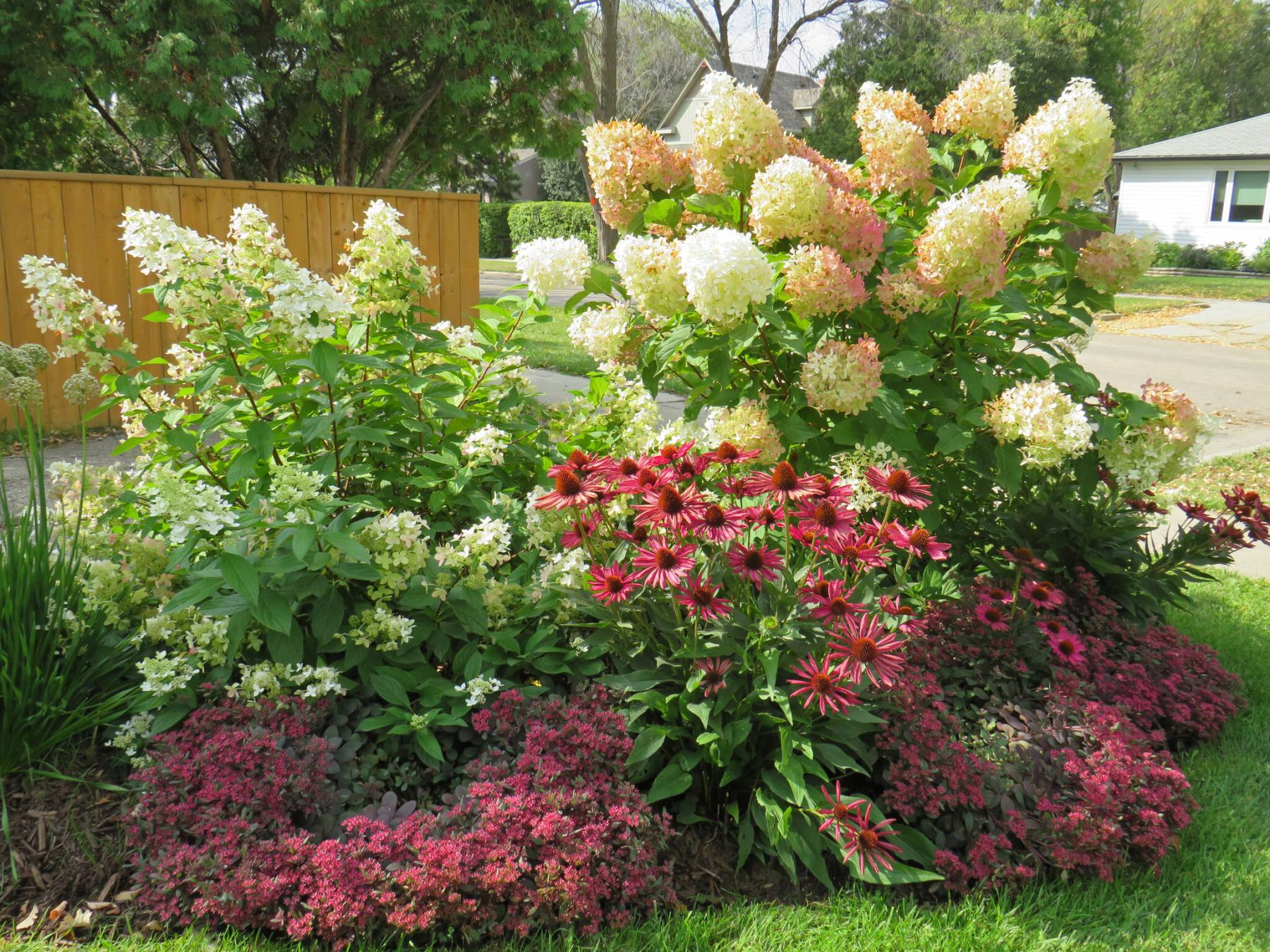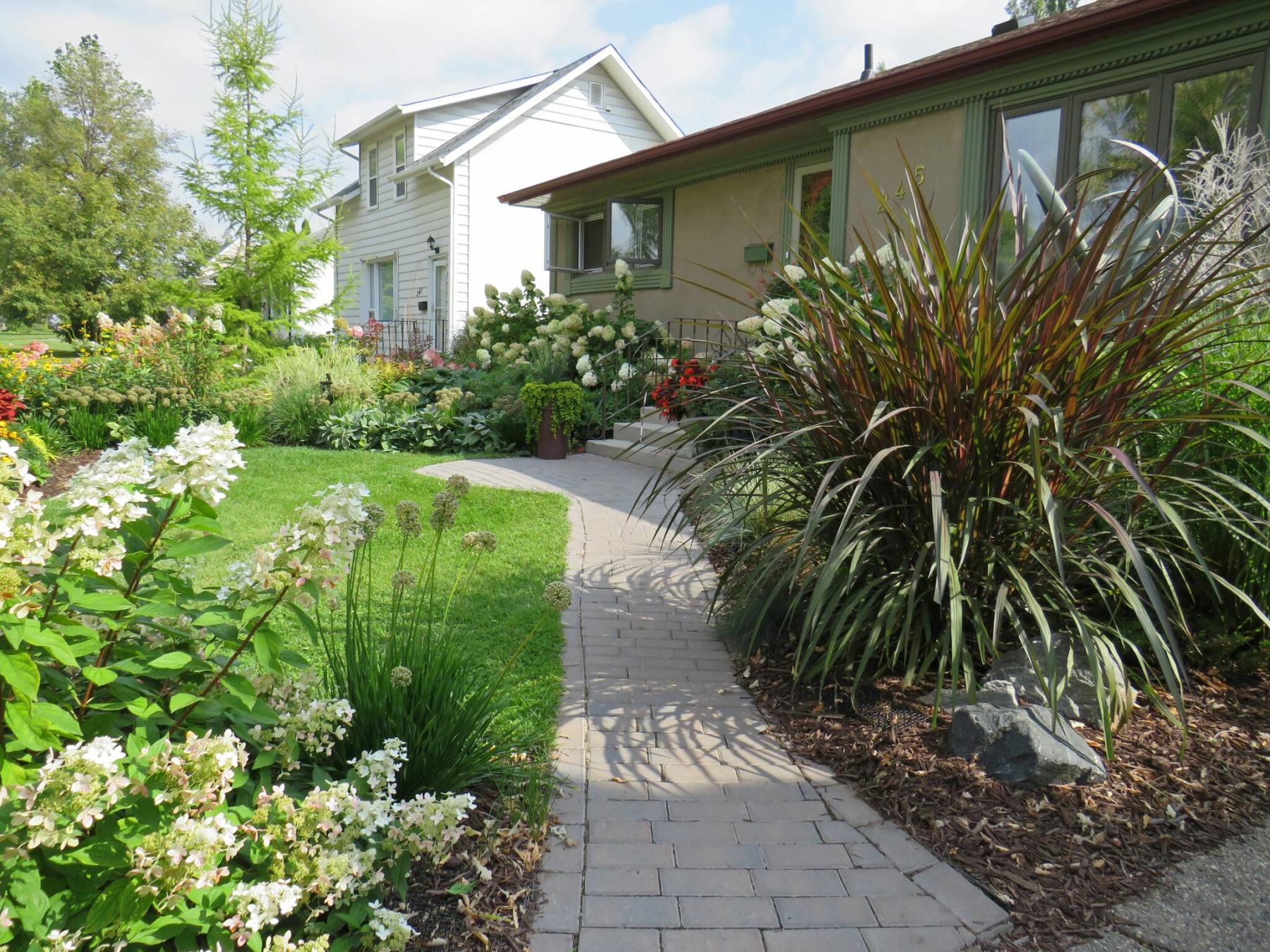
Annual Vertigo grass and perennial Maidenhair miscanthus frame the entrance to this St. James garden where a new flower bed will soon be installed.
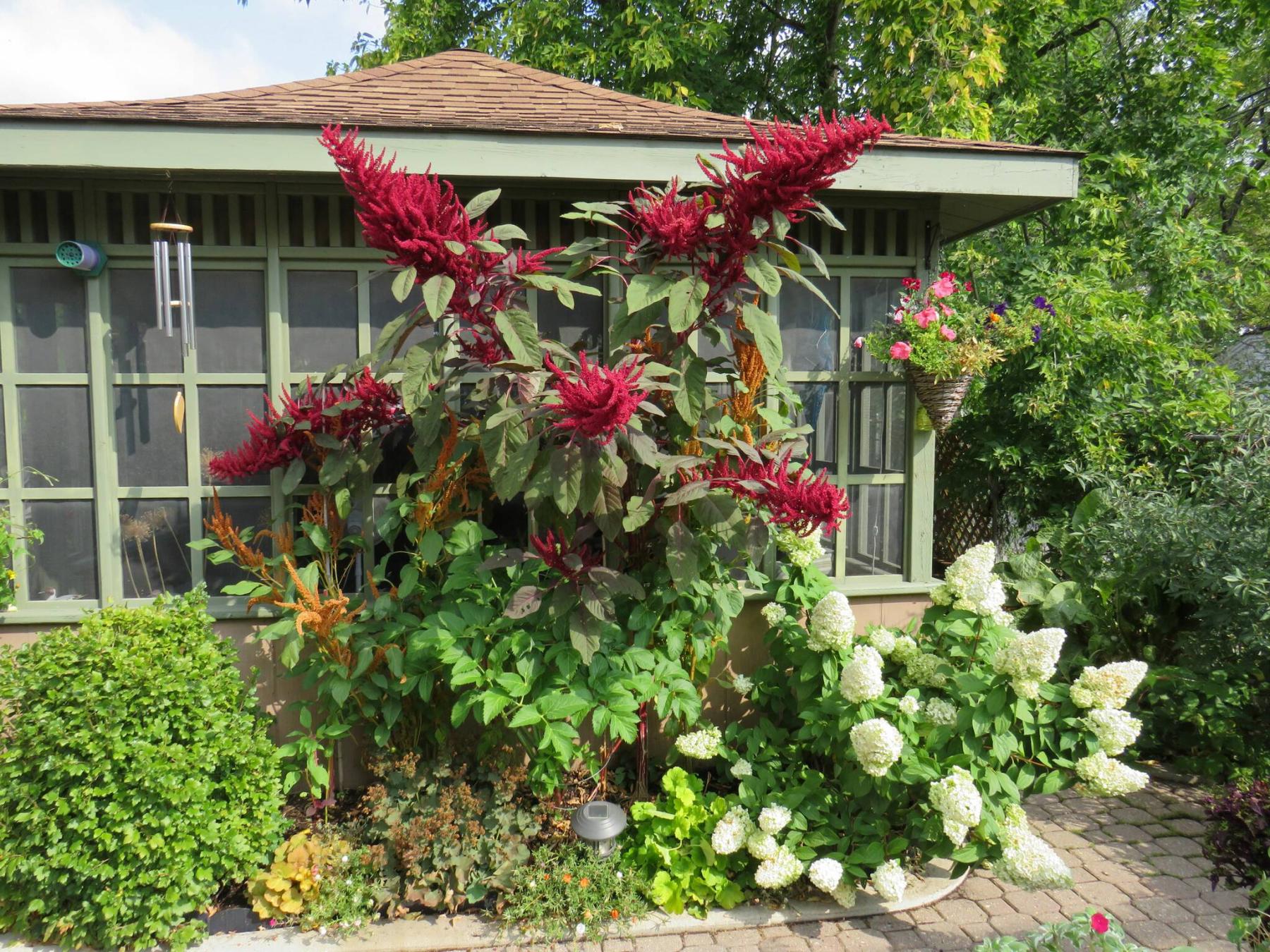
A sage green wooden gazebo is the backdrop to a giant red amaranthus next to the creamy blooms of Moonrock hydrangea.
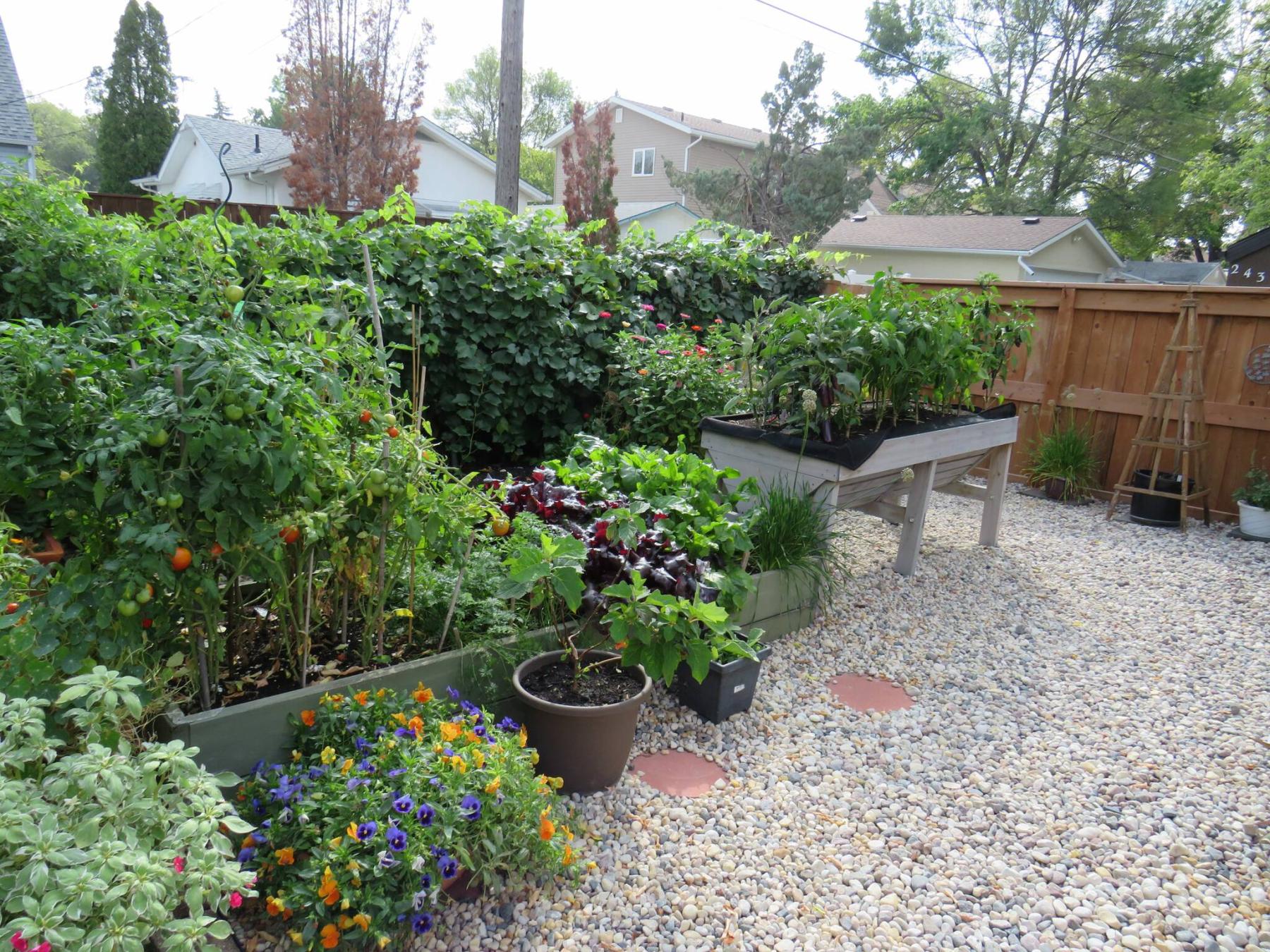
Next spring, an archway with a climbing hydrangea and raised beds on either side with Quick Fire hydrangeas will decorate the entrance to this veggie garden.
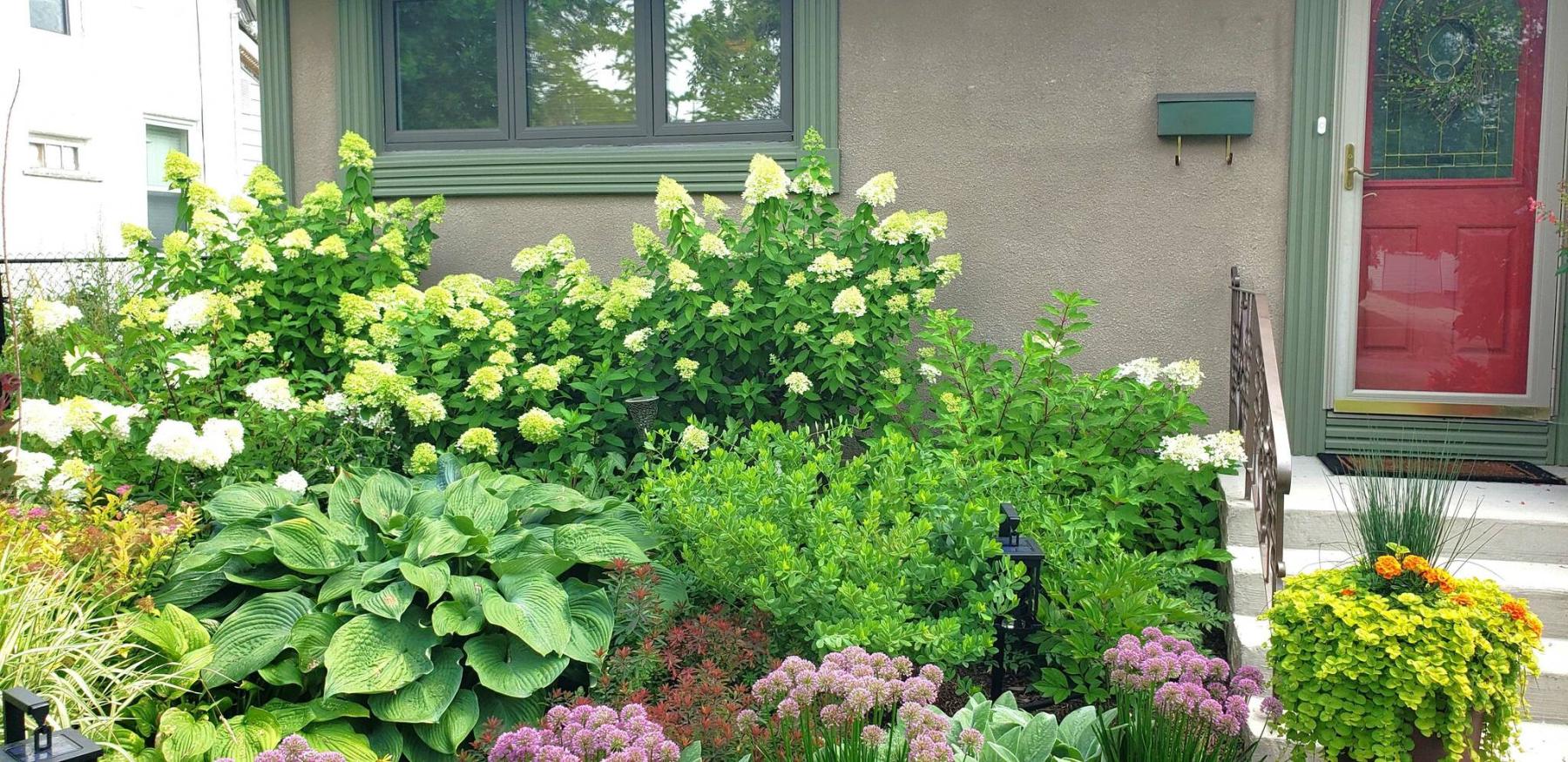
Jeannette Astleford
Colourful perennials and textures complement hydrangeas.
Stewart Astleford cannot help himself. He is in love with hydrangeas. “They are a most beautiful plant and I do love them,” says his wife, Jeannette, “just not as much as he does.” Stewart currently grows 22 different varieties of hydrangeas — in many cases, multiples of each — and has plans to plant more in their St. James garden. Jeannette maintains an inventory of Stewart’s growing hydrangea collection, but she also has a keen eye for design and creates contrasts in colour and texture with an eye-catching combination of annuals and perennials that complement the big, beautiful blooms of Stewart’s hydrangeas. Together, their unique perspectives have led to the creation of a stunning four-season garden that glows in September.
Stewart’s love affair with hydrangeas started with Annabelle. The most well-known hydrangea variety, Annabelle has extremely large flowers that start out green and then turn white. The grand dame of Hydrangea arborescence cultivars, Annabelle is long-lived but does not have sturdy stems. No matter, plant supports keep her upright. Stewart also grows Invincibelle Spirit, the first-ever pink Annabelle hydrangea.
The panicle hydrangea, however, is the dominant hydrangea in Stewart and Jeannette’s garden. They grow Limelight and Quick Fire, two popular varieties that were introduced in the early 2000s. Quick Fire is an early flowering hydrangea (first week in July) with lacy blooms that turn dusty rose in September. Limelight’s blooms start out lime green in early August before transitioning to creamy white then soft pink in autumn. Stewart likes to have a combination of hydrangea shrubs as well as hydrangea tree forms which bring height to the garden and provide opportunities for underplanting.
The entrance to the front garden is framed on one side of the curved pathway by a dramatic pairing of two handsome architectural grasses that stand six feet (183cm) tall — Vertigo, an ornamental grass which has purple black foliage and Maidenhair Miscanthus, a perennial grass with silver foliage that shimmers in the sunlight. On the opposite side is a garden bed planted with a Phantom hydrangea tree-form and a Confetti hydrangea shrub, two varieties that are seldomly available at local garden centres. Phantom’s enormous creamy flowers with tints of pink in fall are even larger than Limelight’s bountiful blooms. Confetti’s blooms are long, narrow, and lacy. In the border, Jeannette has created a complementary colour scheme with SunSparkler Plum Dazzled sedum and Echinacea Kismet Raspberry coneflowers. Hydrangeas grow only more beautiful in September and the rich colours of Plum Dazzled and Kismet coneflowers combine for a dazzling effect.
Vanilla Strawberry hydrangea is a standout in the Astleford’s late-season garden with full flowers that transition from white to deep rosy pink. Little Lime Punch, a more compact panicle hydrangea than robust Vanilla Strawberry, also offers a fantastic colour show in this lovely garden with its bi-coloured, rosy pink blooms. One can’t help but marvel at the size and number of the inflorescences on Stewart’s hydrangeas and their depth of colour.
What is his secret? Stewart amends his soil with a premium garden soil mix which contains compost and black loam into which he incorporates mushroom compost. He feeds the hydrangeas with a slow-release granular fertilizer in spring which he supplements with Miracle Gro Water Soluble Bloom Booster once the hydrangeas start blooming. He also feeds his hydrangeas with banana peels. He chops them up into smaller pieces then puts them into a blender and pours the slurry into the soil around his hydrangea shrubs and tree-forms. He also takes care to conserve moisture in all the garden beds with a layer of mulch. Soaker hoses provide supplemental moisture directly to the roots of plants. “None of my hydrangeas drooped during the heat of summer,” says Stewart.
This fall, Stewart plans to dig up more of the lawn in his front yard so that he can create a new flower bed along the path that leads into the garden. Three Early Evolution hydrangeas, an extremely dwarf (12-24 in. or 30-60cm) paniculata variety that he purchased in spring will go into the new bed. Early Evolution is hardy to Zone 4 and will benefit from the protection of good snow cover which the front yard typically receives. Early Evolution hydrangea blooms earlier than most panicle hydrangeas and has white flowers that age to salmon-pink.
Stewart and Jeannette’s backyard garden is a revelation. It’s not only that there is not one blade of grass or that it has a larger footprint, but the perennials, shrubs, succulent containers, potted tropicals, vegetables, and structural elements are all so diverse in character. Suffice it to say, Jeannette and Stewart garden year-round. Once temperatures cool, they will move tender succulents, cacti, and banana plants indoors. For now, their backyard space is alive with the sounds of water and the invitation to sit and relax on their deck or around the firepit or inside their sage-green wooden gazebo, an inspired, romantic structure. A giant red amaranthus grows against an outer wall of the greenhouse and next to it, a lush white-flowered Moonrock panicle hydrangea. Incredibly, the amaranthus was discovered in spring as a volunteer growing in an area of crushed rock in the garden. Jeannette plans to save the seeds this fall.
Stewart grows so many interesting hydrangea varieties in his backyard including Hydrangea petiolaris, a climbing hydrangea. Next spring, the climbing hydrangea will be relocated so that it grows on an archway he plans to create between two raised beds planted with Quick Fire hydrangea. Miss Saori, a Zone 5 double-petalled Hydrangea macrophylla that was named Plant of the Year at the RHS Chelsea Show in 2014, will need extra protection this winter as will Hydrangea quercifolia Gatsby Pink, a Zone 5 oakleaf hydrangea. Non-hardy hydrangeas can be overwintered in various ways: by digging a trench and completely covering the shrub or storing them in an unheated garage once they are fully dormant.
But two other unique hydrangeas — Hydrangea serrata Tuff Stuff, a mountain hydrangea, and Let’s Dance Sky View, a Zone 4a Hydrangea macrophylla that is crossed with Hydrangea serrata — should both be able to survive our cold winter if they receive some added protection. “I put a lot of leaves around the base of my hydrangeas for winter,” says Stewart.
Stewart believes it is important to add at least one new hydrangea to his garden each year and has now set his sights on Little Hottie, a new compact panicle hydrangea that scored high marks in plant trials for its stellar performance in extreme heat. The large, prolific flowers open green, change to creamy white, then turn light pink in late summer as temperatures start to cool. Should I tell him about Hydrangea paniculata Pinky Winky Prime, a brand-new introduction for 2024? Pinky Winky Prime knocks it out of the park with bigger, fuller blooms that age to a deeper pink than the original Pinky Winky which was introduced in 2008. Pinky Winky Prime will bring considerable impact to the landscape with its unique, pointed panicles and impressive height and width that ranges from six to nine feet (1.8-2.7m). My guess is that Pinky Winky Prime will soon find her way into Stewart and Jeannette’s garden.
colleenizacharias@gmail.com

